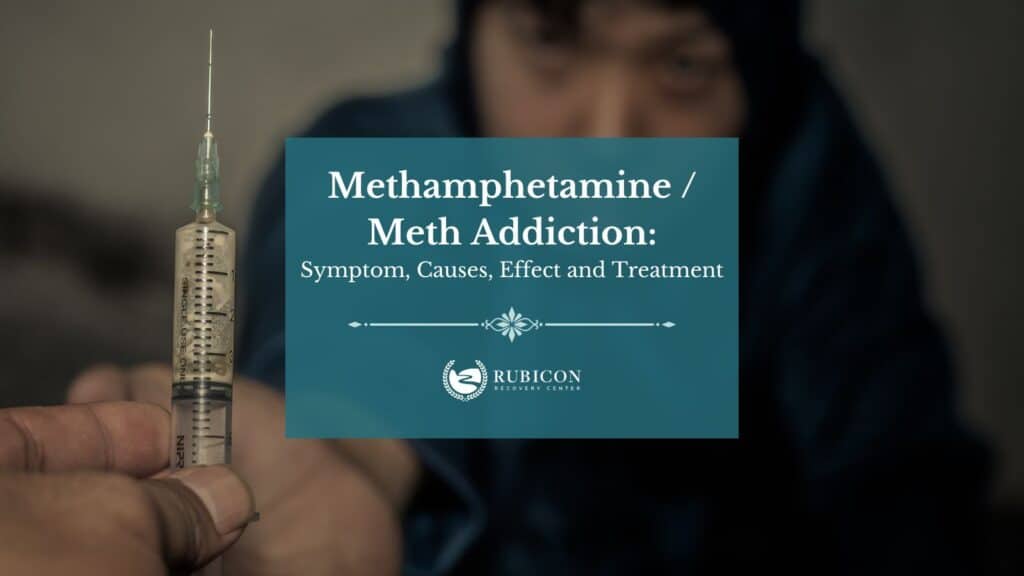The prevalence of methamphetamine (meth) addiction in the U.S. has grown over the years, leading to several cases of hospitalization and overdose deaths, as recorded by the Centers for Disease Control and Prevention (CDC) in 2021. In the data by the CDC, more than 32,000 people died from an overdose involving psychostimulants, primarily meth.
Symptoms of methamphetamine addiction include increased energy, decreased appetite, paranoia, and erratic behavior. Withdrawal symptoms of methamphetamine addiction include fatigue, depression, increased appetite, and intense drug cravings.
Causes of methamphetamine addiction stem from genetic predisposition, environmental factors, social influences, and psychological vulnerabilities. Treatment options for methamphetamine addiction often involve behavioral therapies, such as cognitive-behavioral therapy (CBT) and contingency management, along with support groups and medication-assisted treatment (MAT) in some cases.
What is Methamphetamine Addiction?
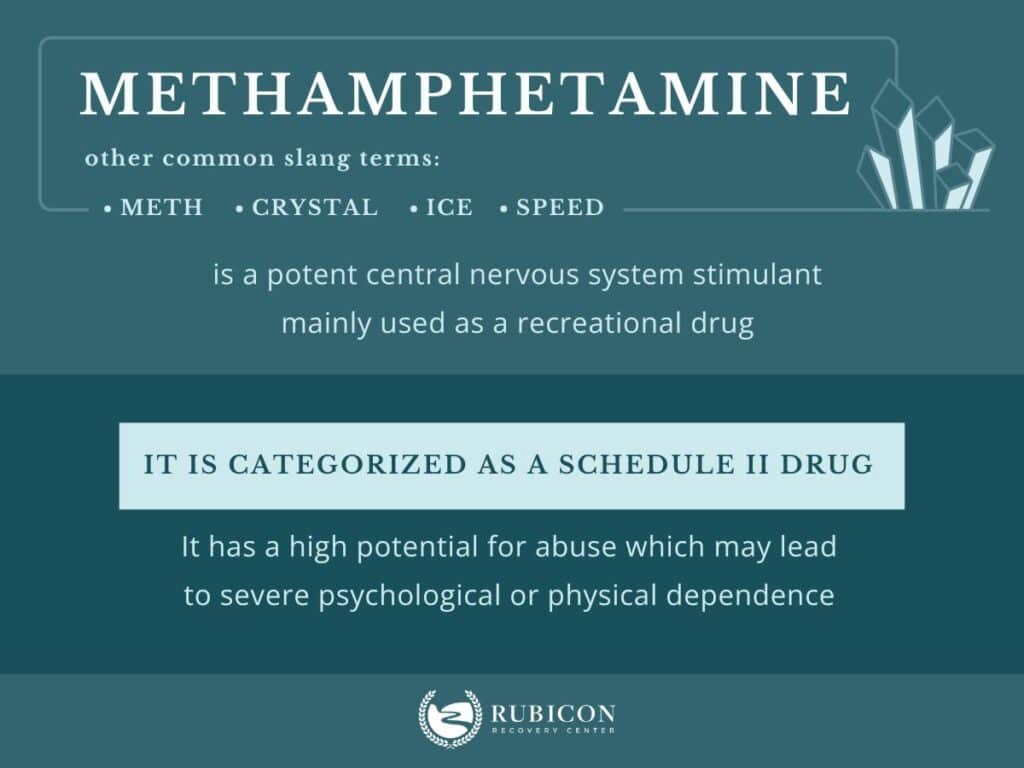
According to a 2021 National Survey on Drug Use and Health (NSDUH) among people aged 12 or older in 2021, 0.9% (or about 2.5 million people) reported using methamphetamine in the past 12 months (2021 DT 1.1).
Methamphetamine is a synthetic drug that directly affects the brain’s neurotransmitters, causing a rush of euphoria and energy. However, this high is extremely short-lived, lasting only 4-12 hours. To maintain the high, people end up taking the drug repeatedly, often in binges that can last for days.
Over time, methamphetamine addiction develops. The brain becomes dependent on the artificial stimulation provided by the drug. People start craving meth obsessively and will do anything to obtain and use it, despite the devastating consequences.
What are the Signs and Symptoms of Meth Addiction?
The symptoms of meth addiction encompass physical, behavioral, and psychological problems, including unexplained weight loss, skin sores, dilated pupils, memory loss, paranoia, and many more:
- Rapid weight loss and malnourishment
- Skin sores, acne, and “meth mouth” (severe tooth decay and loss)
- Dilated pupils and excessive sweating
- Tremors, twitching, and jerky movements
- Irregular heartbeat and high blood pressure
- Difficulty sleeping for days at a time
- Hyperactivity, agitation, and restlessness
- Erratic, unpredictable, and violent behavior
- Paranoia, hallucinations, and psychosis
- Picking at the skin or engaging in repetitive behaviors
- Neglecting hygiene, appearance, and grooming
- Stealing, lying, or engaging in other criminal activities to obtain meth
- Intense cravings and preoccupation with obtaining meth
- Mood swings, anxiety, and depression
- Lack of motivation and apathy about life outside of meth use
- Memory loss and problems with cognition
- Psychosis, including delusions and auditory hallucinations
An addicted person will experience all of these symptoms all at once. However, they’ll experience many of them at different stages in the addiction cycle.
What are the Effects of Meth Addiction?
Methamphetamine addiction can have devastating short-term and long-term effects, including increased energy and libido, elevated heart rate, seizures, severe tooth decay, delusions, damaged blood vessels, and more:
Short-Term Effects:
- Euphoria and increased energy, confidence, and libido
- Decreased appetite and rapid weight loss
- Erratic and aggressive behavior
- Paranoia, hallucinations, and psychosis
- Elevated heart rate, body temperature, and blood pressure
- Seizures and cardiovascular problems
Long-Term Effects:
- Severe tooth decay and tooth loss (“meth mouth”)
- Irreversible brain damage and cognitive impairment
- Psychosis, including delusions and auditory hallucinations
- Damaged blood vessels and increased risk of stroke
- Liver, kidney, and lung damage
- Malnutrition and weakened immune system
- Violent, erratic, and criminal behavior
- Financial ruin, job loss, and relationship problems
- Increased risk of contracting HIV, hepatitis, and other infectious diseases
The long-term effects of methamphetamine abuse are particularly severe and often irreversible, even long after an individual stops using. The combination of physical, psychological, and social consequences makes meth addiction extremely difficult to overcome without professional treatment and a strong support system.
How does meth addiction damage the kidney?
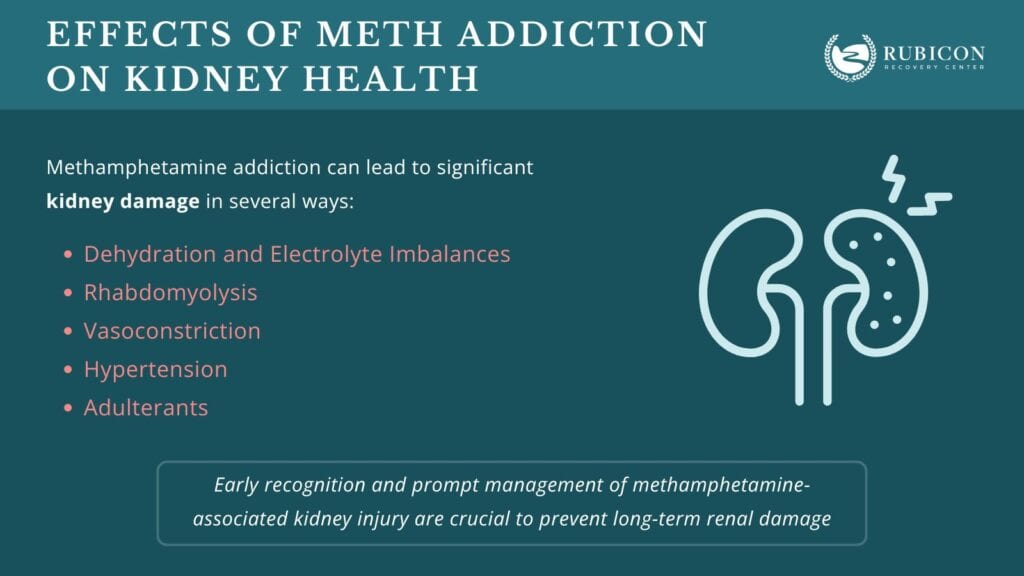
Methamphetamine addiction can lead to significant kidney damage in several ways:
- Dehydration and Electrolyte Imbalances: Meth suppresses the appetite and causes excessive sweating, leading to severe dehydration and electrolyte imbalances that strain the kidneys.
- Rhabdomyolysis: Meth causes the rapid breakdown of muscle tissue, releasing myoglobin that clog and damage the kidneys.
- Vasoconstriction: Meth’s stimulant effects cause blood vessels to constrict, reducing blood flow to the kidneys and causing acute kidney injury.
- Hypertension: Chronic meth use elevates blood pressure, which over time damage the delicate filtering structures within the kidneys.
- Adulterants: Street meth is often cut with harmful chemicals that are directly toxic to the kidneys.
According to research by Tiffany Ku, MD, et al (2019) titled Methamphetamine-Associated Kidney Injury and published in the Clinical Journal of the American Society of Nephrology reviewed the various kidney-related complications associated with methamphetamine use, including acute kidney injury, rhabdomyolysis, and chronic kidney disease. The study concluded that early recognition and prompt management of methamphetamine-associated kidney injury are crucial to prevent long-term renal damage.
What are the Causes of Meth Addiction?
The causes of meth addiction range from biological and genetics to psychology, peer pressure, life trauma, and lack of proper education on meth addiction:
1. Biological Factors
Methamphetamine is an extremely powerful stimulant that directly impacts the brain’s reward and pleasure centers. It causes a massive release of dopamine, the neurotransmitter responsible for feelings of euphoria and well-being. Over time, the brain becomes desensitized to normal dopamine levels, requiring higher and more frequent doses of meth to achieve the same “high.” This profound neurological adaptation is a key driver of the intense cravings and compulsive meth-seeking behavior seen in addiction.
2. Psychological Factors
Many individuals with mental health issues such as depression, anxiety, ADHD, or post-traumatic stress disorder may turn to meth as a means of self-medication. The temporary sense of confidence, focus, and escape that meth provides can offer relief from painful emotional states. However, this pattern quickly leads to dependence as the brain becomes reliant on the drug’s effects. Underlying trauma, chronic stress, and poor coping mechanisms also increase susceptibility to developing a meth addiction.
3. Environmental Factors
The widespread availability and relatively low cost of methamphetamine, especially in certain geographic regions, play a major role in facilitating addiction. Easy access combined with social circles where meth use is normalized powerfully influences an individual to experiment with and continue using the drug.
The 2012 research by Brandon DL. Marshall et al, titled Individual, Social, and Environmental Factors Associated with Initiating Methamphetamine Injection: Implications for Drug Use and HIV Prevention Strategies, highlights that a high incidence of methamphetamine (MA) initiation was observed, particularly among young injection drug users (IDU), stimulant users, homeless individuals, and those involved in the city’s open drug scene. The study found that individual, social, and environmental factors significantly increased the likelihood of initiating MA use among established injectors.
4. Genetic and Hereditary Factors
Research indicates there may be a genetic predisposition to developing substance use disorders, including meth addiction. Certain genetic markers and neurochemical profiles can make some individuals more prone to experiencing the euphoric effects of meth and becoming trapped in the cycle of dependence. If a person has a family history of addiction, they may face an elevated risk of also struggling with meth abuse.
5. Co-Occurring Disorders
Alarmingly, methamphetamine abuse often co-occurs with the use of other substances such as alcohol, opioids, or cocaine. This poly-substance abuse exacerbates the neurological and psychological effects, making the addiction exponentially more severe and difficult to treat. Individuals may use meth to enhance or counteract the effects of other drugs, creating a dangerous and complex web of substance dependencies.
6. Peer Pressure and Social Influences
Exposure to methamphetamine use within an individual’s social network can powerfully normalize and encourage addiction. Peers or family members who are active meth users may introduce the drug, provide it freely, and create an environment where meth abuse is seen as acceptable or even expected behavior. This social pressure and the desire to fit in can lower an individual’s inhibitions and lead them down the path of meth addiction.
7. Lack of Education and Prevention
Insufficient public awareness about the severe and long-lasting consequences of methamphetamine use allows addictions to develop unchecked. Without access to comprehensive education on the dangers of meth, individuals may underestimate the highly addictive nature of the drug and the immense difficulty of breaking the cycle of abuse. Lack of effective prevention programs, especially in high-risk communities, contributes to the continued spread of meth addiction.
8. Trauma and Adverse Life Experiences
Unresolved trauma, such as childhood abuse, neglect, or other forms of adversity, can drive individuals to self-medicate with methamphetamine. The drug’s ability to provide a temporary escape from painful emotions and feelings of dissociation can offer a seductive, though ultimately harmful, coping mechanism. Over time, this pattern of abuse becomes entrenched, making it increasingly difficult to address the underlying trauma without also tackling the meth addiction.
The study “Childhood Abuse, Neglect, and Household Dysfunction and the Risk of Illicit Drug Use: The Adverse Childhood Experiences Study” by Dube et al. (2003) published in Pediatrics examined the relationship between adverse childhood experiences (ACEs) and the risk of illicit drug use. According to the study, The attributable risk fractions due to ACEs for illicit drug use problems were 56%, for drug addiction 64%, and for parenteral drug use 67%.
10. Socioeconomic Factors
Poverty, unemployment, and lack of access to quality healthcare and addiction treatment resources are all socioeconomic factors that can contribute to higher rates of methamphetamine abuse. Individuals struggling with financial instability, limited educational opportunities, and social marginalization may turn to meth as a means of coping with their circumstances or seeking a sense of empowerment and control.
A team of researchers led by Dr. Beth Han from NIH’s National Institute on Drug Abuse (NIDA) examined data from almost 200,000 people nationwide. The study highlighted that low educational attainment and household income are associated with methamphetamine use and methamphetamine use disorder (MUD).
What are the Withdrawal Symptoms of Methamphetamine?
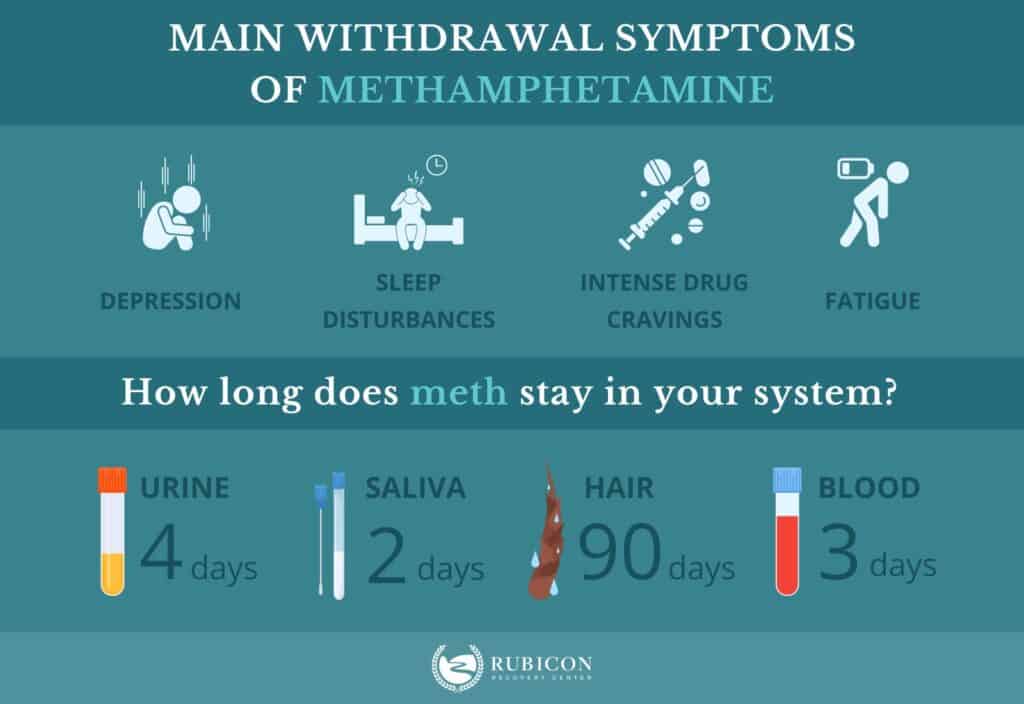
The withdrawal symptoms experienced when stopping methamphetamine use include intense cravings, fatigue, depression and anxiety, lack of concentration, paranoia, and suicidal thoughts:
- Intense Cravings: Individuals will experience an overwhelming urge to use meth again, as the brain has become dependent on the drug’s effects.
- Fatigue and Exhaustion: Users may feel extremely tired and lethargic, with a lack of energy and motivation.
- Depressed Mood: Withdrawal can trigger feelings of depression, sadness, and hopelessness.
- Anxiety and Irritability: Meth users may become anxious, on edge, and easily irritated during the withdrawal process.
- Anhedonia: The inability to experience pleasure or joy, a common symptom as the brain struggles to restore normal dopamine levels.
- Increased Appetite: Individuals may experience intense hunger and cravings for food, often leading to weight gain.
- Difficulty Concentrating: Meth withdrawal can impair cognitive function, making it challenging to focus and concentrate.
- Insomnia and Disrupted Sleep: Users may have trouble falling asleep or staying asleep, leading to further fatigue and agitation.
- Psychosis and Paranoia: In severe cases, meth withdrawal can trigger hallucinations, delusions, and paranoid thoughts.
- Suicidal Ideation: The combination of depression, anxiety, and the intense cravings can increase the risk of suicidal thoughts or behaviors.
These withdrawal symptoms can persist for several weeks to months, depending on the severity and duration of the meth addiction.
What are the Treatment Options for Meth Addiction?
Treating methamphetamine addiction requires a comprehensive, multi-faceted approach that addresses the various biological, psychological, and social factors underlying the addiction. The main treatment options for meth addiction include:
1. Detoxification
The first step in treating meth addiction is to undergo a medically supervised detoxification process. This involves safely managing the withdrawal symptoms and providing 24/7 medical and psychological support to help the individual safely and comfortably stop using the drug. Detox programs may utilize medications, such as antidepressants or sleep aids, to alleviate the physical and psychological discomfort associated with withdrawal.
2. Inpatient/Residential Treatment
For individuals with severe meth addictions or complex co-occurring mental health conditions, inpatient or residential treatment programs may be the most appropriate next step. These intensive programs provide around-the-clock care, structured daily activities, and a supportive, drug-free environment to help the individual focus solely on their recovery. Inpatient treatment typically lasts 30 to 90 days, depending on the individual’s needs.
3. Outpatient Treatment
Less intensive than inpatient programs, outpatient treatment allows individuals to continue living at home while attending regular therapy sessions, support group meetings, and other recovery-oriented activities. This approach is often suitable for those with a strong support system or less severe addictions. Outpatient treatment can include individual counseling, group therapy, and medication-assisted treatment.
4. Behavioral Therapies
Evidence-based behavioral therapies, such as cognitive-behavioral therapy (CBT) and contingency management, are highly effective in treating meth addiction. CBT helps individuals identify and modify the thought patterns and behaviors that contribute to their drug use, while contingency management uses a system of rewards to reinforce positive, drug-free behaviors.
The study by Shoptaw et al. (2005) titled “Behavioral treatment approaches for methamphetamine dependence and HIV-related sexual risk behaviors among urban gay and bisexual men” investigated the efficacy of different behavioral treatments for reducing methamphetamine use and associated sexual risk behaviors among high-risk populations.
The study concluded that behavioral treatments, including drug abuse treatments, produced significant reductions in methamphetamine use and sexual risk behaviors.
5. Medication-Assisted Treatment
While there are no FDA-approved medications specifically for meth addiction, certain medications can be used to manage withdrawal symptoms and cravings. These may include antidepressants, anti-anxiety medications, or prescription stimulants (e.g., bupropion) that can help restore dopamine balance in the brain.
6. Support Groups and Peer-Based Recovery
Participation in support groups, such as Crystal Meth Anonymous or Narcotics Anonymous, can provide invaluable peer support, accountability, and a sense of community during the recovery process. These groups offer a safe space for individuals to share their experiences, coping strategies, and commitment to sobriety.
7. Aftercare and Relapse Prevention
Successful recovery from meth addiction requires ongoing support and relapse prevention strategies. This may include regular therapy sessions, participation in support groups, sober living arrangements, and the development of a robust social support network to help maintain long-term abstinence.
8. Harm Reduction Approaches
While the ultimate goal is to achieve abstinence, harm reduction strategies can be beneficial for individuals who are struggling to quit meth or are at high risk of relapse. Harm reduction approaches aim to minimize the negative consequences of drug use, such as providing clean needles, overdose prevention education, and facilitating access to medication-assisted treatment.
The book “Harm Reduction: Pragmatic Strategies for Managing High-Risk Behaviors” by Marlatt, Larimer, and Witkiewitz is a comprehensive work that discusses the principles, strategies, and applications of harm reduction. It encourages the incorporation of harm reduction strategies into practice to engage a broader range of individuals in treatment and ultimately reduce harm at both individual and population levels.
9. Holistic and Alternative Therapies
Complementary and alternative therapies, such as acupuncture, meditation, yoga, and exercise, can be valuable adjuncts to traditional addiction treatment. These holistic approaches can help manage withdrawal symptoms, reduce stress and cravings, and promote overall well-being during the recovery process.
10. Family Therapy and Counseling
Involving the individual’s family members or significant others in the treatment process can be highly beneficial. Family therapy can help repair damaged relationships, improve communication, and provide a supportive environment for the individual to maintain sobriety.
11. Specialized Programs for Specific Populations
Certain populations may require tailored treatment programs to address their unique needs, such as gender-specific programs for women, adolescent-focused programs, or programs designed for LGBTQ+ individuals or those with co-occurring mental health disorders.
13. Sober Living Environments
Transitional housing, such as sober living homes or halfway houses, can offer a structured, drug-free living environment for individuals in the early stages of recovery. This can help bridge the gap between the intensive treatment setting and reintegration into the community.
The study by Polcin, D. L., Korcha, R., Bond, J., & Galloway, G. (2010) titled What did we learn from our study on sober living houses and where do we go from here? Journal of Psychoactive Drugs, 42(4), 425–433, provides valuable insights into the role of sober living houses (SLHs) in supporting recovery from alcohol and drug dependence. The findings support the recovery model used by SLHs, which includes active involvement in 12-step programs and the development of social support systems with fewer alcohol and drug users
Treating meth addiction is a complex and challenging process, but a comprehensive, evidence-based approach that addresses the multifaceted nature of the disorder can significantly improve the chances of achieving and sustaining recovery.
What are the Different Forms of Methamphetamine?
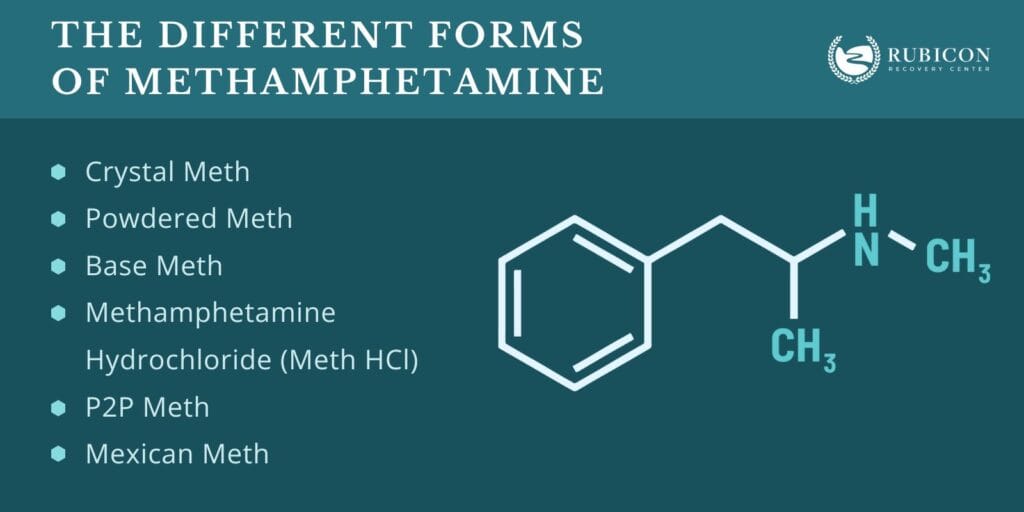
Methamphetamine, also known as meth, crystal meth, or speed, can take on several different forms, each with its own unique characteristics and potency. The main forms of methamphetamine include:
- Crystal Meth: This is the most commonly known and potent form of methamphetamine. Crystal meth appears as clear, crystalline shards or rocks that resemble glass or ice. It is typically smoked or injected, producing an intense, long-lasting high.
- Powdered Meth: Powdered methamphetamine, often referred to as “speed,” is a fine, white, crystalline powder. It can be snorted, swallowed, or dissolved in water and injected.
- Base Meth: Also known as “base,” this form of methamphetamine is a viscous, oily, or waxy substance that can be yellow, brown, or off-white in color. It is typically smoked or injected.
- Methamphetamine Hydrochloride (Meth HCl): This form of meth is a water-soluble, crystalline powder that can be taken orally, snorted, or injected. It is sometimes referred to as “meth salt” or “ice.”
- P2P Meth: P2P meth, or phenylacetone methamphetamine, is a less potent form of the drug that is produced using a different synthesis method. It is typically a coarse, granular powder.
- Mexican Meth: This term refers to methamphetamine produced in Mexico, which is often more impure and adultered compared to domestically produced meth in the United States.
What are the different slang names for meth?
Some common slang terms for methamphetamine include:
- Crystal
- Ice
- Glass
- Crank
- Speed
- Chalk
- Tweak
- Shards
- Meth
- Tina
- Crypto
- Quartz
- Trash
- Stove Top
- Yaba
- Shabu
What are the Law Enforcement Efforts on Meth Addiction?
Overall, the U.S. law enforcement approach to the methamphetamine crisis involves a multi-pronged strategy that combines supply reduction, demand reduction, and community-based collaboration
1. Federal Initiatives
At the federal level, the Drug Enforcement Administration (DEA) leads the charge against methamphetamine. The DEA works to disrupt the supply of meth by targeting major drug trafficking organizations, monitoring precursor chemicals, and collaborating with international partners.
2. Specialized Task Forces
Many state and local law enforcement agencies have established specialized task forces dedicated to combating the methamphetamine problem. These task forces often involve partnerships between various law enforcement agencies, as well as cooperation with public health and social service organizations.
3. Prescription Drug Monitoring Programs
To address the diversion of over-the-counter and prescription drugs used in meth production, many states have implemented Prescription Drug Monitoring Programs (PDMPs). These programs track the prescription and distribution of potentially abused substances, allowing law enforcement to identify and investigate suspicious activity.
4. Asset Forfeiture and Financial Investigations
U.S. law enforcement agencies actively target the financial assets and profits derived from the methamphetamine trade. Through asset forfeiture programs and financial investigations, they aim to disrupt the economic incentives that fuel the drug trade.
5. Cross-Border Cooperation
Given the transnational nature of the methamphetamine trade, U.S. law enforcement agencies work closely with their counterparts in Mexico and other countries to disrupt the supply chain and prevent the smuggling of meth and its precursor chemicals across international borders.
6. Community Engagement and Prevention
Law enforcement agencies often collaborate with local communities, schools, and non-profit organizations to implement prevention programs and raise awareness about the dangers of methamphetamine. These efforts aim to reduce the demand for the drug and provide support for those struggling with addiction.
7. Treatment and Rehabilitation Partnerships
Some law enforcement agencies have partnered with treatment providers and recovery programs to offer individuals struggling with methamphetamine addiction the opportunity to seek help and access rehabilitation services as an alternative to incarceration.
Struggling with Meth Addiction?
If you’re battling meth addiction, you’re not alone. Our New Jersey rehab offers personalized support and treatment to help you break free from its grip. Don’t let addiction control your life any longer—reach out today for compassionate care and guidance on your journey to recovery in our meth rehab in nj.
Frequently asked questions
What happens when Xanax and Meth are used together
Mixing Xanax with methamphetamine is extremely dangerous and potentially lethal. Interactions can lead to heart attacks, slowed breathing, unresponsiveness, strokes, and dizziness. Combining benzodiazepines with other meth can have lethal consequences due to the contrasting effects on the body, leading to unpredictable reactions and long-term complications.
What is the difference between Cocaine and Meth?
Despite similarities, meth is man-made, and cocaine is plant-derived. Meth’s high lasts 8-24 hours, while cocaine’s lasts 20-30 minutes. Meth’s half-life is 12 hours, cocaine’s is one hour. Meth is neurotoxic, damaging serotonin and dopamine neurons, and increases dopamine release and blocks reuptake, unlike cocaine.
Share This Post
